#american crayfish
Explore tagged Tumblr posts
Text
Today's Tanka 19:sometimes with picture

In paddy fields
give a shout
Bullfrog
wild voice
Anthem of victory?
水田(みずた)にて
雄叫び(おたけび)あげる
ウシガエル
野太き声は
勝利の凱歌?
Bullfrogs, usually heard from rivers, were heard from paddy fields. I can even sympathize with the bad food that even American crayfish eats.
(2016.08.04)
2 notes
·
View notes
Text
Utrecht council and water company Waternet have called in aquatic ecologists to combat the rise of American crayfish in a new experiment using plants, predatory fish and AI. The crayfish – Procambarus clarkii, or red swamp crayfish – are thought to have travelled from their native United States in the ballast tanks of large freighters and are well adapted to local waterways. They are particularly common in Utrecht, Noord-Holland and Zuid-Holland. First spotted in Dutch waters in 1985 and largely without any natural enemies, crayfish numbers are now thought to be running into billions. Their presence is said to be a threat to water flora and fauna and they also damage to river banks. In the Molenpolder near Maarssen the crayfish have demolished practically all plant and animal life, aquatic ecologist Winnie Rip told the Telegraaf. “They are opportunists. If one species runs out the turn to the next. They muddy the water which causes a decline in plants and animals and, ultimately, biodiversity.
continue reading
#netherlands#invasive species#american crayfish#decapoda#cambaridae#procambarus clarkii#biological controls#catfish#bladderwort#ai
0 notes
Photo

Cowbuddy Crawfish by Nat Power [shop]
262 notes
·
View notes
Text
Waaaah I had my last field day today (╥_╥)
It was absolutely gorgeous and we saw a lot of cool critters





#wrenfea.exe#from the field#crayfish#crawdad#american eel#hellgrammite#dobsonfly#bugblr#aquatic insects#aquatic macroinvertebrates
9 notes
·
View notes
Text
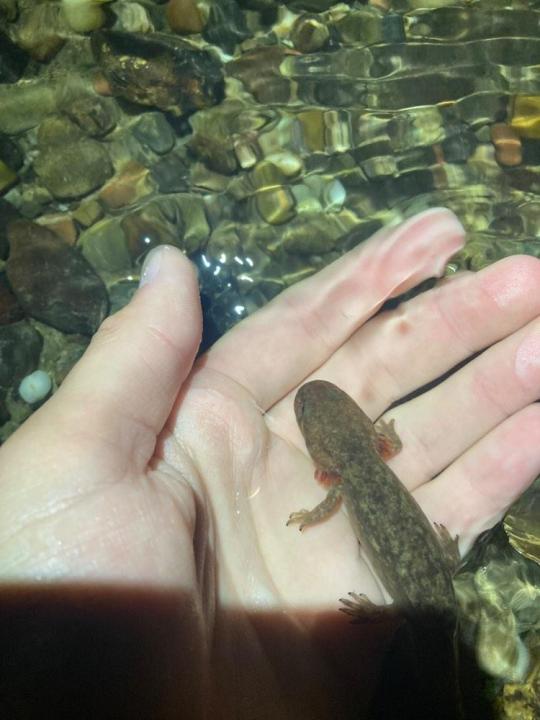

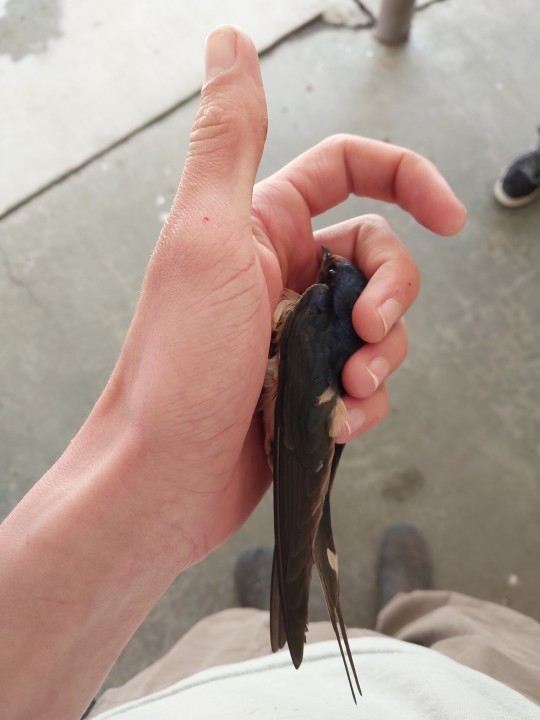
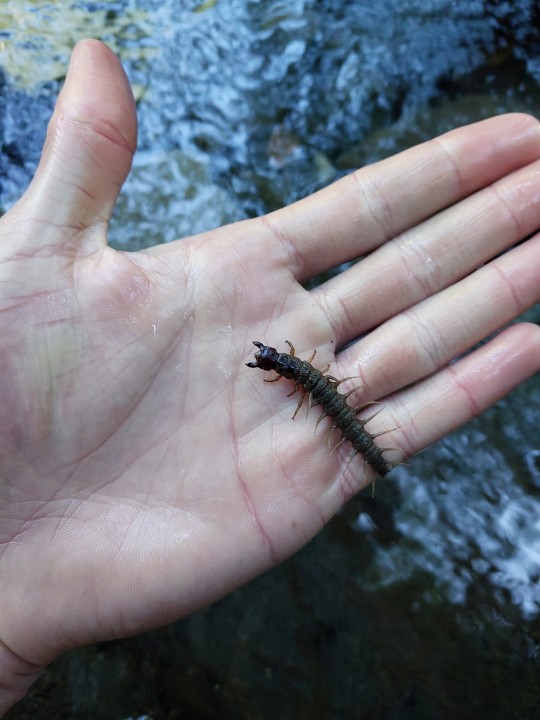
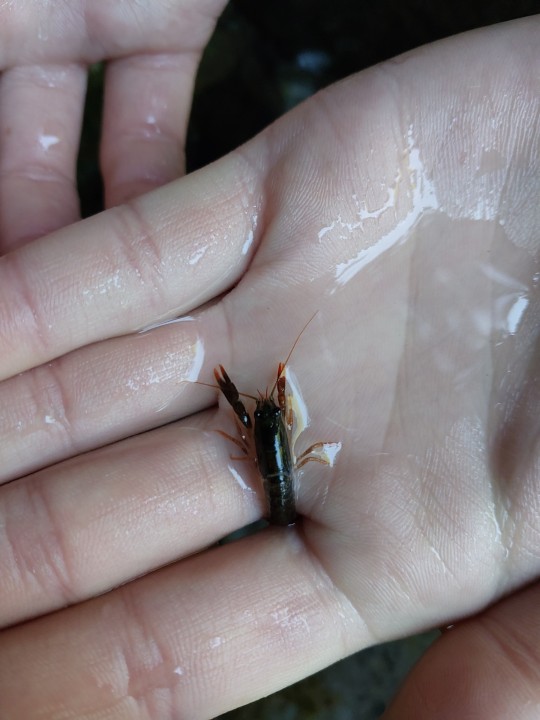
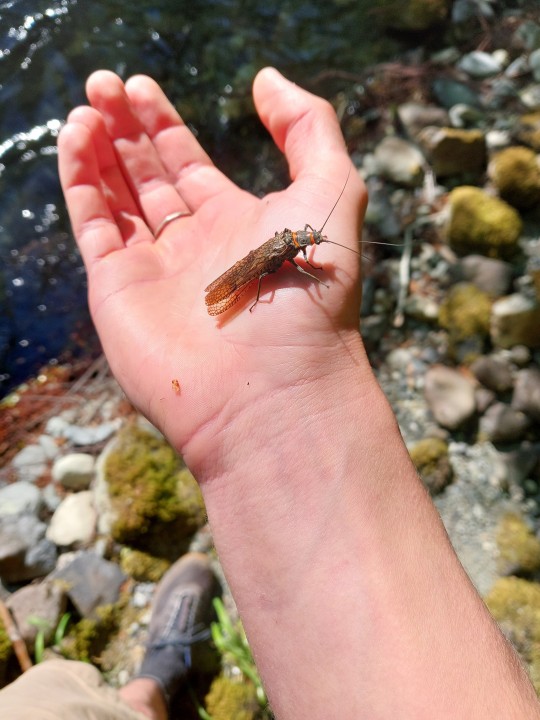
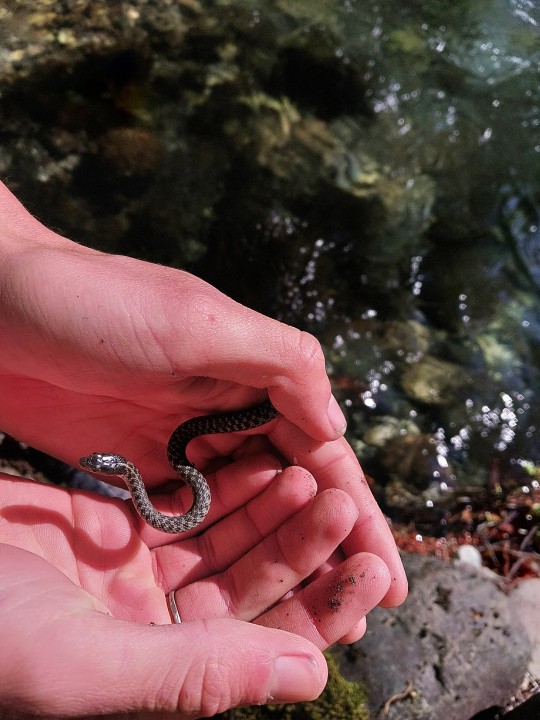

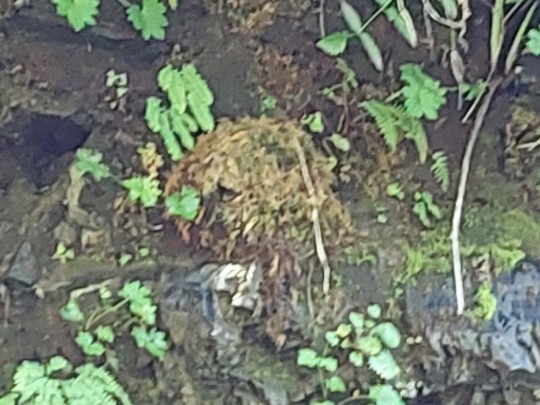
fFucking creatures post
fun fact theres no picture here of the American Dipper (bird) but the last picture is of its nest- dippers are so sick they can like jump into fast-moving streams and angle their wings downward to use the water pressure to hold them at the bottom while they walk along and look for aquatic arthropods
also any time they are standing around they kind of like... bounce??? like theyll sort of bend and unbend their knees and just do a little pop squat every couple seconds
extremely good bird
#salamander#salamander larva#dicamptodon#i think#lamprey#a fucking lamprey#barn swallow#i caught a bird with my hand#hellgrammite#is the coolest name ever#aquatic insects#dobsonfly#crawdad#i refuse to call it a crayfish just like i refuse to call sea stars starfish#yabbie is acceptible#stonefly#garter snake#of some sort#bee#that landed on my arm while i was posting this#american dipper#bird nest#its like a little cave built out of moss????
3 notes
·
View notes
Text
europeans will never understand the pure childhood joy of catching crawdads in the creek and boiling them up with some potatoes and corn. that was so awesome
#are there even crawdads in europe?#i would assume there would be?#also ive always called them crawdads but they also can be called crayfish or crawfish or mudbugs#europeans do you guys have crawdads?#have any of you ever tried a crawdad boil?#i grew up in rural southern missouri so it was a big part of life#but even some of my american friends who grew up in the city or suburbs haven’t a clue what that even is
2 notes
·
View notes
Text
We need more big crabs in gaming. Maybe even giant crayfish too.
#art talks about stuff#for any americans reading this post in this instance the term crayfish refers to spiny lobsters (Palinuridae)#as that's what i know as crayfish
0 notes
Text




the american dipper, also known as the water ouzel, is a small semiaquatic bird found in central america & portions of north america. this bird was the favorite bird of renowned naturalist john muir. they feed on aquatic insect larvae along with other small aquatic prey like crayfish. due to their size, they are sometimes preyed on by large fish like trout. they have nictating membranes that allow them to see underwater, along with scaled nostrils that block water from entering their beaks, making them skilled underwater hunters. they are good indicators of water health, and they are rarely found in polluted waters.
940 notes
·
View notes
Text
Round 2 - Arthropoda - Malacostraca




(Sources - 1, 2, 3, 4)
Malacostraca is the second largest class of crustaceans, and what most people picture when they hear the word crustacean! It contains over 40,000 species separated into 17 orders: Leptostraca, Stomatopoda (“Mantis Shrimp”), Decapoda (“Crabs”, “Lobsters”, “Crayfish”, “Shrimp”, and “Prawns”), Euphausiacea (“Krill”), Thermosbaenacea, Mysida (“Opossum Shrimp”), Stygiomysida, Lophogastrida, Spelaeogriphacea, Mictacea, Bochusacea, Cumacea (“Hooded/Comma Shrimp”), Tanaidacea, Amphipoda, Isopoda, Anaspidacea, and Bathynellacea. Many are scavengers, some are predators, some are herbivores, some are filter feeders, and some are parasites.
Malacostracans live worldwide, in marine, freshwater, and terrestrial environments, and have a large diversity of body forms. They are united by their segmentation of 20-21 body segments divided into a 5-segmented head, an 8-segmented thorax, and a 6-segmented abdomen with a telson, except in Leptostraca which has 7 abdominal segments. They have a pair of jointed appendages on each abdominal segment, though some groups have lost them secondarily. In some, three thoracic segments may be fused with the head to form a cephalothorax, the associated legs becoming maxillipeds. They have two pairs of antennae, which often branch into two parts. Their mouthparts have a pair of mandibles, maxillules, and maxillae. Many taxa have compound eyes on moveable stalks. Some have a carapace which covers the head, part or all of the thorax and some of the abdomen. The carapace may be fused with some of the thoraacic segments or hinged with two parts. This is one of the most diverse classes in the animal kingdom, and their anatomy and behavior would be hard to summarize further in just one paragraph!
The oldest malacostracans are the Leptostracans, which first appeared as fossils from the Cambrian period.

Propaganda under the cut:
“Carcinisation” has become a meme meaning “everything becomes crab”, but it actually only refers to the phenomenon of decapods convergently evolving crab-like anatomy. The Infraorder Brachyura contains the “True Crabs”, but at least 5 groups of unrelated decapods have evolved similar anatomy: a flat and broad cephalothorax.
Stomatopods (“Mantis Shrimp”) are known for their excellent color vision, but they probably can not actually see “shrimp colors.” They can see ultraviolet and polarized light, but their excess of photoreceptor cells actually lets them process their environment faster than we can, rather than differentiate between a multitude of different colors. This allows them to have quick reaction times, either to escape predators, fight or flee from rivals, or strike at their prey with amazing speed.
Malacostraca contains the largest living arthropods: the Japanese Spider Crab (Macrocheira kaempferi) with a legspan of up to 4 metres (13 ft) long, and the American Lobster (Homarus americanus), which can get up to 20 kilograms (44 lb).
Many species of malacostracans are commonly kept as pets, including crabs, crayfish, shrimp, mantis shrimp, and isopods.
Cute creb eat a cherry:

130 notes
·
View notes
Note


Omniscient hand reaches down and uses two blisteringly warm appendages to pick up unsuspecting victim who is angered upon experiencing this development
THAT FISH CRAY!!! - ONT, Canada:
I;m not great with crayfish ID, but this looks a lot like Northern Clearwater Crayfish (Faxonius propinquus), family Cambaridae., which I know you have up there.
Any North American crayfish experts have any opinion on this?
222 notes
·
View notes
Text
things I loved about jjk265
I love how both yuuji and sukuna were so casual with one another despite their feud and hatred for one another. this is enough of a proof to me that in another world, despite all the things that set them apart, they could actually get along.
I love yuuji’s continuous yapping and sukuna’s grumpy face for the good part of the chapter. honestly, this really shows just how patient sukuna is lol.
I love how yuuji didn’t mind sukuna’s snarky insults at him like it’s something he’s totally used to by now.
I love how yuuji is just a little shit and teases sukuna for shits and giggles
“try it out. unless the strongest sorcerer in history can't catch some crayfish?” ... “you got an american crayfish. japanese ones are way more rare." “what was that?” “you heard me.”
I love all Sukuna’s “……………” moments throughout the chapter like he was either confused, contemplating or thinking about how to answer.
I love how yuuji was actually really competitive and got cheeky whenever sukuna outperformed him at something.
I love how chill and sarcastic sukuna was. he likes to insult yuuji without ever giving any boasting comments about himself.
I love how yuuji got excited for simple and silly things
I love how sukuna indulged yuuji in all the activities he picked for them.
I love how yuuji wanted to give sukuna a chance and try to show him compassion, despite everything sukuna put him through.
I love how sukuna didn’t mock or insult yuuji for seeing value in others but rather told him that he himself just doesn’t feel anything (he mocked yuuji's hatred towards him tho because of course he did. he just couldn't let it slide and had to let yuuji know that he sucks even at hating him lol).
I love how yuuji’s face fell after realising he didn’t succeed and how his eyes turned hostile when he decided to show sukuna mercy
And I love how furious sukuna became right after he said he doesn’t feel anything.
I love how in the close up of yuuji’s eye you really can’t tell whether it’s yuuji or sukuna. it’s such a juxtaposition it makes my head spin.
I love how yuuji wanted sukuna to understand him and reach him in one way or another.
and I love how sukuna struggled to keep his walls of indifference up throughout the whole chapter and how in result he kept contradicting himself.
and most importantly I love how both of them showed a side of themselves to the other no one else got to see. yuuji showing sukuna his childhood and compassion and sukuna showing yuuji a part of his "human" side.
#I absolutely loved both yuuji and sukuna in this chapter#this all feels so surreal to me I can't believe I got to witness such growth from both of them in real time#itadori yuuji#ryomen sukuna#jjk 265#itasuku#jjk leaks
193 notes
·
View notes
Text
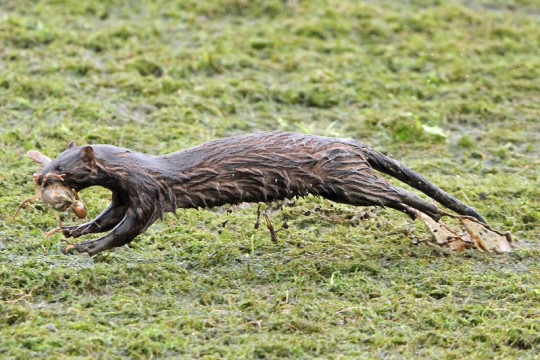
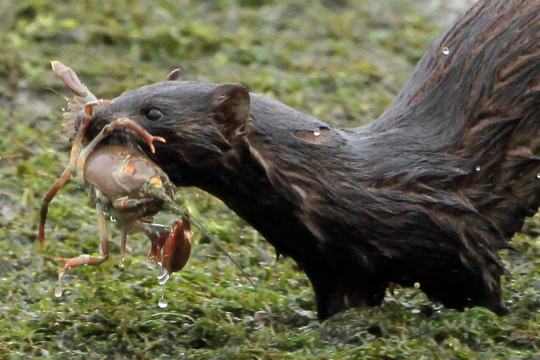
American mink (Neogale vison) with a crayfish
Photos [1, 2] © Critter Cam
2K notes
·
View notes
Text
A Tiny Man Among Men: Kiryu Boss Rush

oh boy this one was a real hoot. we got two new cards with it that I want to show off because they’re so fun


look at them!! that’s the fish he caught in the opening of Y3!!!!!
summary: Shortly after moving to Okinawa, Kiryu faces down with his most cunning foe yet--a crayfish.
2007 Not long after Kiryu came to Okinawa... Kiryu was invited by a local resident named Uchima to help with a river clean-up event (tl note: name is 内間)
Kiryu: Uchima-san... Is this the river we're supposed to be cleaning up?

Uchima: Sure is. Filthy, right? It's usually beautiful, but inconsiderate people keep throwing garbage into it. Uchima: It's particularly bad right now... I clean trash out of it every month, but before I know it there's more trash than ever. Kiryu: ...That's awful. Uchima: I think up stream's a bit prettier, so how about you handle that since it's your first time. Kiryu: No, I'm fine right here. You should do the up stream. Uchima: ...Eh? A-Are you sure? I'll take you up on that kind offer, I've been having some awful back pain. Kiryu: Sure. I'll do it. Uchima: Well then, I'll get going, and if you need anything just let me know. Uchima: ...Oh, right. Kiryu-san, please watch out for the animals. Kiryu: ? Watch out for... animals? Uchima: During clean-ups, I've had crows and rats and other such animals knock over the trash and cause all sorts of issues. Uchima: Since these are the elite survivors of all the extermination activities done in this area, a lot of them are strangely intelligent. Uchima: This one time a weasel snuck into our house, got into our fridge, and stole all of our food--and mice have been pooping on the mouse traps, almost like they were making fun of us humans... Kiryu: ...Heh, so it's that kind of situation. I got it. I'll be careful. Uchima: Great, see ya then. <he leaves> Kiryu: ...Alright, let's get to it.

<sounds of Kiryu splashing around in the river> Kiryu: ...Whew. Plastic bottles in a convenience store garbage bag... how can someone just dump this in a river...

Kiryu: Seriously... Who the hell would... <a blade-like sound happens> Kiryu: ...Guh!? What the!? American Crayfish: ................. (tl note: also known as the red swamp crayfish, Procambarus clarkii. I'm shortening it just to crayfish from here on)

Kiryu: A crayfish!? ...It was in the trash's crevice!? <another slicing sound, Kiryu steps to the side> Kiryu: Kh... You're quick on your feet... Crayfish: ..... Kiryu: It's back on top of that garbage again. Kiryu: ...I just want to clean up that trash. I don't mean you any harm... so let's just be adults here...

Crayfish: ....! <some kind of hissing sound?> Kiryu: ...No good. If I reach towards it any further, it will definitely catch me. On the other hand, I can't just leave this garbage here. Kiryu: What can I even do here? <a long moment passes in silence> Kiryu: I've got it. There was some dried squid in the trash I just picked up. I'll use it as bait to draw the crayfish away from here. Kiryu: ........Loook, is this some dried squid? Isn't that tasty? Wouldn't it be nice to eat~?

Crayfish: ............. Kiryu: C'mere, c'mereeee, won't you~? If you won't eat it, maybe I should~? Crayfish: ............. Kiryu: ...No reaction at all. Maybe it's not hungry? (tl note: he's so mad that his plan didn't work)

Kiryu: (If that isn't going to work... Then there's gotta be something else that will guy this guy to move.) Crayfish: ...Shaaa! <more hissing, and it smacks into Kiryu before bouncing back> Kiryu: !?

Crayfish: Munch... munch... Kiryu: I-It... took advantage of my momentary lapse in concentration... It took the squid!? Kiryu: Uchima-san said "there are smart animals around here"... don't tell me... this guy's one of them!!?? (tl note: Kiryu. you may be stupid) Crayfish: Shaaaa! Kiryu: ....Excellent. If a battle of wits is what you want, I'll show you what human intelligence is like...!

<Kiryu ducks down> Kiryu: (...Good, this rock is exactly what I need. Now... Just gotta throw it behind it...) <the rock goes sailing with a comical whistle and a tiny splash> Crayfish: .....! Kiryu: (...Great. Now I can catch it when it's distracted and has its back turned...) Crayfish: .............. Kiryu: ............... Crayfish: .................... Kiryu: (It didn't turn around.....!? Could it be... it read my intentions....?) Crayfish: ............. Kiryu: Actually, where is this guy looking...... It's like there's something behind me..... Crayfish: ....! <another hiss and a slicing sound as Kiryu gets crayfish'd> Kiryu: Guh!

Kiryu: (This guy... the moment I turned my head... it went and pinched me on my damn ass...) Kiryu: (Was its gaze a trap...? Did it read my intentions... and then decide to get revenge?) Kiryu: ...What a clever crayfish. Kiryu: ........ Kiryu: ...Heh, you beat me. I guess I'll give up on those trash bags. <Kiryu leaves> Crayfish: ................... Kiryu: (...But, that was just to make it look that way... The moment it lets its guard down... I'll catch it...!) <Crayfish hisses at Kiryu> Kiryu: .....! Kiryu: Mmm... it feels good to stretch out my arms. This hand would absolutely for certain never ever be trying to catch you~. Crayfish: ........... Kiryu: (Yes, its defenses are down... now!) <The crayfish hisses again> Crayfish: .....! Kiryu: ....! Mmmm... still just stretching out my arms~.

Kiryu: (Damn... It's not turning around yet... what a distrusting creature.) Kiryu: (Yes... now---) <Crayfish hisses again, now with Kiryu much closer> Crayfish: ....! Kiryu: ...Ahhh~. Stretching my arms feels so good~.

Kiryu: (Damn... this guy... How many times is it going to look back here...) Riverside Resident A: ...That person... What's that person doing? Riverside Resident B: It looks like he's playing "Red Light Green Light" with a crayfish... I wonder if that poor guy doesn't have any friends... Kiryu: (...Shit... The stares of passersby are painful...) Kiryu: (I don't think continuing like this is going to get me anywhere... Maybe it's time to abandon this tactic...) Crayfish: ...Shaashaaa.... Kiryu: (It... waved its pincers like a peace sign... Could it be that this is what it wanted?) Kiryu: (In order to humiliate me, did it play along by pretending to be fooled..?) Kiryu: (Just how smart is this thing... and how the hell do I make it leave?) Crayfish: ...Shaaa! <more hissing as it leaps onto Kiryu> Kiryu: !?

Crayfish: Shashaaaa! Kiryu: Guh, this guy... it jumped on me so fast. Kiryu: That was awfully aggressive... I guess you've decided we're total enemies... Crayfish: Sha! .....Shaa? Crayfish: ....Sha!? Sha! Shaaaa! Kiryu: (It... got distracted by a fly... It turned around completely!?) Kiryu: (Heh, no matter how smart it is, in the end it's just an animal... This is my chance... I'm going to catch this thing now!) Kiryu: Haa! <wooshing sound> Crayfish: ....Sha! <slicing sound> Kiryu: Guhh!? Kiryu: (Stupid... I tried to grab hold of its back, but it pinched my hand...) Kiryu: (I was using its blind spot to catch it... how did it know...) Crayfish: Shashashashasha.... Kiryu: Damn... It's doing that gesture again. Kiryu: (You're kidding... was getting distracted by a fly all an act!? Did it use that as a trap so it could attack me when I got near!?) Kiryu: (It's looking down on me... But now I have to admit that it's smart... maybe even smarter than me...) Kiryu: (Even so... there's still a way to do this... there's something in the trash, I'm sure.) Crayfish: Shaaa! <hissing> Crayfish: ....Shaa!? <it falls into the water> Kiryu: ...Wh-! That guy was swinging its arms around as a threat but then... it fell!? Crayfish: Shaa... Shaa... !? Kiryu: And it landed on its back so it seems it can't get back up. Heh, what an unexpectedly stupid move. Kiryu: This time I'm going to catch you...! Haaa! <another whoosh> Crayfish: ...Sha! <a big slicing sound> Kiryu: ...Heh, of course not being able to get back up was an act too. Kiryu: I knew that you'd try to trick me into another attack like that, since you see me as your enemy and look down on me. Kiryu: But... this time I grabbed you not with my bare hands, but with these disposable chopsticks. Kiryu: Bad luck for you. You didn't pinch my finger... just these chopsticks that were thrown in the river! Crayfish: ...!? Kiryu: I'll throw these chopsticks with you still latched on... then I'll be free to finish cleaning up the trash!! Haa!! Crayfish: ...!! Kiryu: (Yes... It's still holding onto the chopsticks...! Take this...!!) <a crunching sound> Kiryu: ....! Crayfish: Sha... Shaaa...! Kiryu: Damn... so the chopsticks were rotten huh... The couldn't withstand the force of the throw and broke...

Kiryu: I was so close to getting this guy out of here... Crayfish: ...Shaa! Kiryu: You're a clever thing, I don't think the same trick will work on you twice. That said, I can't think of any other tricks to try... Kiryu: ...Well, it's fine. I concede. I can't beat you in a battle of wits. Crayfish: Sha? <the music cuts out> Kiryu: ...But, I still have to make this river beautiful. Kiryu: It doesn't matter how many times I get pinched... If I take you head on, I will catch you. Crayfish: ............! Crayfish: Shaaaa!!!!
<EVENT HAPPENS, WHICH IS A BOSS RUSH VS THE CRAYFISH>
Kiryu: Haa... Haa... Haa...!

<Kiryu gets close to the crayfish and grabs it> Crayfish: ....!? Kiryu: ...Whew, I finally caught you. Crayfish: Shaaa! Shaaaa! Kiryu: I'm holding you by your back. You can't get me with your pincers anymore. Kiryu: Finally, I can clean up this garbage... Huh? Small Crayfishes: Shashaa! Kiryu: Inside this garbage there's... baby crayfish... wait, are these your children? Crayfish: Shaa! Shaaa! Kiryu: ....I see. You were just trying to protect them. Kiryu: What I saw as a simple convenience store bag full of garbage was a nest you had to protect. Kiryu: ............ <he sets the crayfish down> Crayfish: .....! Kiryu: I'm sorry for causing a disturbance on your turf. Kiryu: I'll tell Uchima-san and the others to leave your garbage alone. Crayfish: ....Shaaa! <fade to black> Haruka: Oh, you're back Uncle Kaz!

Kiryu: ...Yep. I'm home, Haruka. Haruka: You were doing the river clean-up, right? Did you clean a lot? Kiryu: Yes. Though I almost cleaned up too much, and would have taken away an important home for the animals living there... Kiryu: I'm really glad I noticed it soon enough. Haruka: Is that so... I'm glad. You almost became an "invasive species" to that area, Uncle Kaz. Kiryu: ...Invasive species? Haruka: Yep. I learned about it today in science class. Invasive species take away the habitats of the animals who lived there originally. Haruka: That's why it's bad to release non-native species into the wild. Kiryu: ...I see. I don't know much about that, so I'll have to be mindful. Kiryu: By the way, what kinds of non-native species are there? Haruka: Ummm there's... raccoons, and black bass, and snapping turtle, and american bullfrogs... Kiryu: Woah... So even some of the animals we know. Haruka: Oh, and the american crayfish! Kiryu: A... American crayfish!? Haruka: U-Um, yeah. They eat the native species, spread disease, and damage the ecosystem. Kiryu: What the hell... Kiryu: But... It's not like they're trying to cause trouble, right? Kiryu: If you live, you have to eat and you have to get sick... It's not like they can help it if that ends up being an issue. Haruka: ...Wellll... I guess that's true, but...

Kiryu: Besides, I can assuredly say that this one’s devoted to their family. For their family's sake, they had the bravery to stand up to someone bigger than themself. Haruka: ....This one? Kiryu: I don't know if they were male or female, but they were a true man among men. If they were a human, I'd like to share a drink with them... Kiryu: ...I know. Haruka, why don't you come meet them? I'm sure you'll change your mind if you just meet-- Haruka: Uncle Kaz... did something happen with a crayfish?
<END EVENT>
Bonus stuff:
you don’t understand Haruka the yakuza invasive species are just trying to live their lives the only way they can! and sure they might be destructive but what else can they do? maybe that morally gray father figure crayfish was taking care of orphans!!

#yakuza#rgg#ryu ga gotoku online#Ryu ga Gotoku#like a dragon#Kiryu#Kiryu Kazuma#Haruka#Haruka Sawamura
127 notes
·
View notes
Text
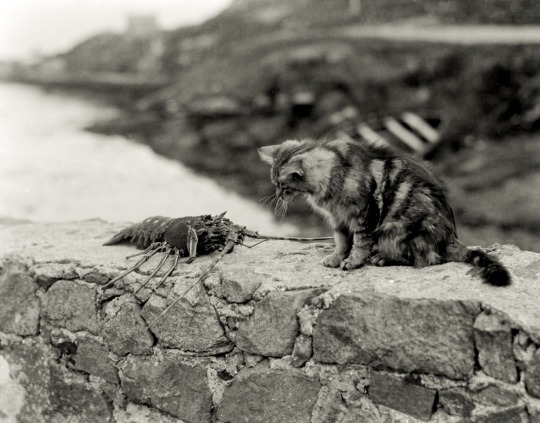
Wicked Willie and the crayfish on the wall outside the Campbell’s house at Northbay, Scotland, 1935 - by Margaret Fay Shaw (1903 - 2004), Scottish/American
253 notes
·
View notes
Note
'The name "crayfish" comes from the Old French word escrevisse (Modern French écrevisse). The word has been modified to "crayfish" by association with "fish" (folk etymology). The largely American variant "crawfish" is similarly derived.
Some kinds of crayfish are known locally as lobsters, crawdads, mudbugs, and yabbies. In the Eastern United States, "crayfish" is more common in the north, while "crawdad" is heard more in central and southwestern regions, and "crawfish" farther south, although considerable overlaps exist.'
This is why!!!!
IT IS NOT BECAUSE THEY ARE '''''GRAY FISH''''''!!!!!!!!!!!

no no. keep talking. I’m fascinated by what argument even lead to this ask,
416 notes
·
View notes
Text
This Wet Beast Wednesday I'm going to talk about gars. This needs some clarification because there are a lot of different fish called gar, garfish, or garpike. I'm referring to fish of the family Lepisostidae, the only surviving members of the ancient clade Ginglimodi, which I mostly brought up because Ginglimodi is a funny name.

(image: a longnose gar)
Gars are predatory fish found exclusively in North and Central America, though they have been introduced outside of their native range. Their ancestors evolved in Triassic period and once occupied most of North America and large portions of Europe back when the continents were still connected. They are freshwater fish, though a few species will go into brackish or even marine waters temporarily. The name "gar" is though to come from the old english word for "spear", which is appropriate as gar are very elongated fish and often have pointy snouts. Many other groups of elongated fish are also given the common name of gar or garfish for this reason. Their long snouts are filled with sharp teeth which are used to crush through shells and flesh. Gars are opportunistic predators who feed largely on crustaceans, frogs, and fish and will eat carrion if they find it. The long snouts are also used to dig through sediment in search of prey They move slowly through the water, but are capable of short bursts of speed to catch prey. Most species are apex predators with no natural predators as adults.
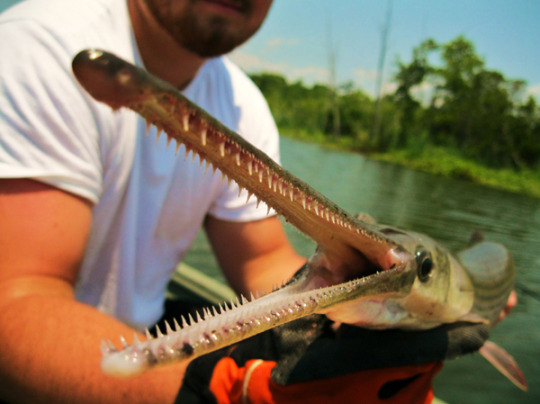
(image: a longnose gar with mouth open, displaying the teeth)
The body of a gar is covered with thick, diamond-shaped scales. Their scales are an ancient variety known as ganoid scales which are notable for their shape and composition. Where most bony fish scales have layers of a spongy, bony substance called cosmene, ganoid scales instead have an enamel-like substance called dentine, which is also a component in teeth. The scales are also covered in a rigid, glassy substance called ganoine where other scales use enameloid. Ganoid scales also don't overlap, instead laying next to each other in a manner that provided protection while still allowing flexibility. The result is a suit of armor that makes gar very durable. Because of how durable the scales are, they habe been used by humans for many purposes. Multiple Native American groups would use scales as arrowheads, there are reports of native Caribbean peoples wearing breastplates made of gar skin, and Europeans colonists would layer their plow heads with the scales to protect the,. There is currently a market for jewelry made of the scales.
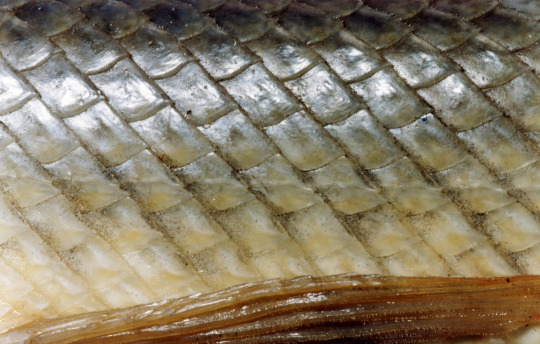
(image: a close-up of ganoid scales)

(image: an arrowhead made of a gar scale)
Gar typically lay their eggs in early spring, with the female coating vegetation with thousands of sticky eggs. The eggs are toxic to humans, capable of causing sickness when ingested. Because of this, they are unsuitable for caviar. Scientists initially thought that the toxin was an adaptation to prevent predation, but natural predators of the eggs like channel catfish and bluegill are immune. Crayfish are affected by the eggs, though it's not clear if the poison is an adaptation targeting them or not.

(image: a shortnose gar)
The swim bladder of gar is highly vascularized, allowing them to act as lungs. Most gar will surface occasionally to take a gulp of air. While they are capable of surviving on their gills alone in good-quality water, air gulping allows gar to thrive in low-oxygen water where their prey will be sluggish from oxygen deprivation. Most species live around 20 years, but the alligator gar can live upwards of 70 years.
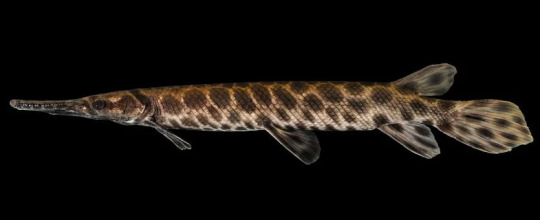
(image: a spotted gar)
There are seven living species of Gar: the Cuban gar, tropical gar, spotted gar, longnose gar, shortnose gar, Florida gar, and alligator gar. The shortenose gar is the smalles species, reaching an average length of 62.5 cm (24.6 in) while the alligator gar is the largest species and one of the largest of all American freshwater fish at an average length of 1.8 m (6 ft) in length. The largest alligator gar on record measured in 2.57 m (8 ft 5 in) and 148 kg (327 lbs). Alligator gar were long considered a nuisance species by fishermen as they preyed on sportfish and as a result, they were frequently killed. This resulted in population losses and the fish being extirpated from many states it was once native to. Now multiple states have laws and regulations protecting them and the population is starting to see a resurgence. Alligator gar and now a popular sportfish and have been introduced to places outside of their native range, becoming an invasive species in many areas including China.
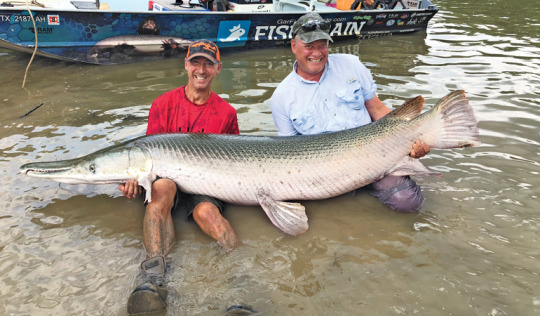
(image: two fishermen with an alligator gar)
Gar meat is edible and is described as having a very unique taste compared to other fish meat. They are not commonly eaten in modern times, but some people consider them a delicacy. Gar meat is known to carry environmental toxins like pollutants and heavy metals, which can make eating them risky. Gar are mostly fished for their scales or for sport. Only the Cuban car is endangered (and critically so) while other species may be locally endangered, but as a whole are not threatened. Gar are used as aquarium fish due to their unique appearance, though they need large tanks due to their size.
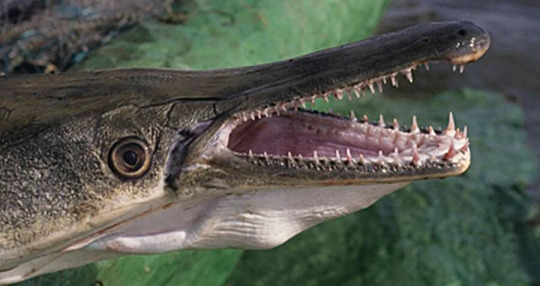
(image: a close-up of an alligator gar's head)
#wet beast wednesday#aquatic biology#fishblr#fish#ecology#zoology#animal facts#gar#longnose gar#shortnose gar#alligator gar
575 notes
·
View notes